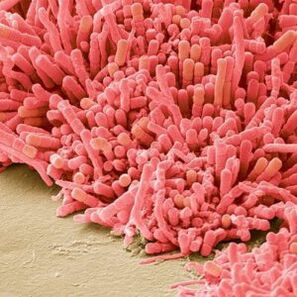
The papilloma is a benign cutaneous neoplasm characterized by the papilla base of the connective tissue, which is covered with an epithelium on top. Papillomas occur in humans in different areas of the body (skin, mucous membranes, internal organs, and other localizations) and in most animals.
Papillomas develop from transient or squamous epithelium into dilute dense formations on the so-called stem. These formations are usually 1-2 centimeters in diameter and have a white or dirty brown outer surface. Sometimes the papillomas grow in different directions and become like a cauliflower or a rooster comb.
Papillomas are removed for cosmetic purposes if they occur in visible areas of the body - the neck, arms, face - but if they occur in many areas of the mucous membrane, such as the larynx, they can cause permeability disorders that endanger the patient. life. In the case of the larynx, the papilloma can block the airways, causing problems with sound or the inability to breathe normally, and in the case of the bladder, the papillomas provoke hematuria. If more papillomas form in the body, this indicates the onset of papillomatosis.
Etiology of papillomas
The occurrence of papillomas is largely provoked by a viral infection, human papillomavirus (HPV), although sometimes papillomas can occur congenitally or as a complication of inflammatory diseases.
When HPV enters the human body, activity usually begins to show after a long time. Often, some provocative factors contribute to the activation of the papillomavirus, resulting in the appearance of soft neoplasms on the skin or mucous membranes. The main factors provoking papillomas, experts include stress, loss of immunity, weakening of the body due to treatment, lack of vitamins in the body, damage to the skin.
Basically, people are sexually infected with the papillomavirus, but there are also possible home infections with very low immunity or damaged areas of the body that can come in contact with an HPV carrier. The appearance of papillomas indicates the activation of an existing virus, which is possible for both women and men. An infant can become infected with this virus while passing through the birth canal of an infected mother.

Classification of HPV manifestations
The human papillomavirus, which infects mucous membranes and skin, can be classified into the following forms:
- Clinical form to be detected by routine examination: genital, papular and papillary warts, exophytic warts, and in women, cervicitis and cervical erosion;
- subclinical form in which the formations have no symptoms are not visible and can only be detected during endoscopy: inverting formations (grow towards the inside of the mucosa), flat warts, and condylomas in the cervical canal;
- a latent form characterized by a lack of clinic and shown exclusively by the results of analyzes;
- Female form or neck form, expressed as cervical cancer or various stages of dysplasia.
When women become infected with highly oncogenic HPV as a result of sexual intercourse, the likelihood of malignancies in the cervical canal is significantly increased. If you are infected with another type of virus, the likelihood of oncology is not so high, however, cancer can occur in the rectum or oral cavity. In men, there is a likelihood of cancer due to HPV in the anus, penis, and rectum.
Types and forms of papillomas
Proper identification of papillomas on the body is very important. Their type depends directly on the strain of the resulting virus, which, when introduced into the human body, contributes to the process of excessive cell division of the skin, resulting in papillomas.
HPV strainscan be oncogenic and non-oncogenic. There are many more non-oncogenic varieties and they usually bring nothing to the patient except for external aesthetic discomfort.
Such a manifestation can be easily removed, thus solving the problem. However, if neoplasms occur in the mucosal area, this indicates serious pathological processes. Such dislocation means that a person is infected with an oncogenic HPV strain, so complex antiviral therapy is extremely necessary. To distinguish between different types of papillomas, it is sufficient to simply compare them with each other and identify the distinguishing features of one or the other subspecies.

Simple Warts
Simple papillomas or warts are the most common type of papillomavirus caused by multiple strains at once. These HPV strains are transmitted not only sexually but also through contact and daily life, leading to statistics showing that 30% of the world’s population has encountered such HPV at least once in their lives.
Simple papillomas or vulgar (common) warts are more often localized in other areas of the upper limbs, namely the hands, but can sometimes occur on the body, soles and feet, palms, fingers. Their special feature is that such warts appear in areas of damaged skin due to a decrease in local immunity. Such papillomas occur in the sole or palm area due to contact with poor quality household chemicals, profuse sweating, various skin damage, dermatitis.
A vulgar wart looks like a papillary neoplasm a few millimeters in diameter at the beginning of the skin at the onset of the disease. In this case, the head of the wart is homogeneous and soft in texture and rises above the surface of the skin. Poorly pigmented, its root gets deep into the skin where it gets nourishment from the blood vessels. As a result of such a diet, the warts gradually grow while not only their size changes but also the degree of pigmentation. In addition, hair often grows in the middle of such papillomas, which is a variant of the norm and does not indicate a malignancy.
Flat papillomas
Such skin growths appear as small yellowish, flat plaques that rise slightly above the surface of the skin. Their structure has a dense, deep subcutaneous root, as evidenced by the frequent pain injured when the wart is pressed or in everyday life. The localization of such papillomas is most often the face and hands. They can sometimes occur in the anus or big lips in women and in the scrotum in men. They have an active upward trend due to active blood supply.
The main feature of flat papillomas is the difficulty of their treatment. After surgical treatment of these tumors, the scars and scars usually remain in place.
Sexual warts
Genital warts occur in the lumbar region or mucous membranes. From the outside, they are thin papillary neoplasms 2-3 mm in diameter. Such condylomas grow rapidly, forming a large skin growth from a small papilla that resembles a cauliflower or a rooster.
The main risk of genital warts is a high risk of infection, inflammation of the vaginal neoplasms, or in women, the labia. They can be easily injured, after which the infection enters the body at high speed. In addition, a major problem with genital warts is the high risk of recurrence, which is not reduced even with the use of antiviral therapy and the removal of neoplasms. Several strains of the virus can cause genital warts, some of which can be dangerous to women for the malignant process.

Filiform papillomas
Threaded papillomas with a thin stem, the top of which is crowned by the head of the neoplasm. Because of their special appearance, it is very difficult to confuse them with other species, so they can be distinguished from other species by looking at a photograph of fibrous papillomas.
Such tumors are most common after the age of 45 in areas where thin skin predominates - the chest, armpits, neck. Increasing the size of such tumors further elongates them. The head of filamentous papillomas is usually yellowish or pink, pigmentation is not expressed, most often very weak.
Internal birthmarks
Any neoplasm on the surface of a person's internal organs can be classified into a subgroup of internal moles. These are intragastric condylomas, papillomas in the rectum, neoplasms in the throat and mouth, neoplasms in the bladder walls. The distinguishing feature of these papillomas is the impossibility of recognition without proper medical procedures and diagnosis. However, the disease is suspected with special symptoms. The risk of such tumors is identified in all cases.
If there are papillomas in the bladder, bleeding or cancer may develop over time.
If the papilloma is located in the larynx, it helps block breathing and interferes with the person's speech functions.
Lewandowski-Lutz papillomas
Warty epidermodysplasia or Lewandowski-Lutz papilloma is a very rare condition that mainly affects only children or adolescents. Sometimes such a disease can be inherited and spread in a family.
The clinical picture of the disease is manifested in the form of a number of reddish-brown spotted warts in the foot and hand area. One feature of the pathology is that when papillomas are located on parts of the body exposed to ultraviolet radiation, in a third of cases, they are born into malignancies and grow into the area of adjacent tissues.

Papilloma localization sites
Filamentous, vulgar, or pointed papillomas, as well as condylomas, are the most common in the practice of physicians. The location of filamentous warts is on the face, vulgaris is more often on the feet or hands, and condylomas are exclusively on the mucous membranes (in the head and urethra of the penis in men, in the area of the labia and vagina in women), butany of these warts may occur in an unusual location for themselves.
Such papillomas are not difficult to remove under modern conditions, but the danger is that new papillomas may appear as immunity declines, with more serious health consequences, such as the subsequent occurrence of genital warts with the development of cervical cancer in women. Plantar warts most commonly occur on rough soles and toes. A spike may form on your thumb after severe damage to the skin in the area.
In general, papillomatosis is a generalized form of pathology in which neoplasms develop throughout the human body. These increases have a characteristic appearance, so once the manifestations of the disease are seen, it can no longer be confused with other diseases.
Symptoms of HPV
The most common symptom of the papillomavirus in the human body is the appearance of papillomas on the skin.
The rest of the symptoms depend directly on the location and type of the disease. Depending on the signs above, the symptoms of HPV may include:
- Genital warts occur on the mucous membranes of the genitals, mouth, larynx, rectum, and the inner surface of the stomach. Symptoms of the onset of pathology in the genital area are itching and unpleasant odor. If such symptoms become bothersome, they should by no means be ignored, as their cause can often be oncogenic in nature.
- Intraductal papillomas in the ducts of the mammary glands, which are signs of redness in the nipple area, mild itching and burning. Furthermore, if you press the nipple with such a papilloma, an ichor or green secretion will begin to leak out of it. The danger of intraductal papilloma is its gradual and possible degeneration into breast cancer.
- Plantar warts are expressed in active calli in the plantar area that cause sharp pain when walking or pressing.
- Papillomas in the larynx are not initially expressed with any specific symptoms, but gradually this pathology leads to a change in human voice, a coma in the throat, and impaired respiratory function. In addition, the patient experiences difficulty swallowing.
- Adolescent flat warts most commonly occur on the outer sides of the hands and the lower part of the face. The symptoms are very vague and are most often expressed in mild, rare itching of the neoplasms.

Pathogenesis
In the presence of HPV in the human body, it is most often concluded that the immune system is reduced. Once introduced into the body, viruses begin the process of infecting the basal epithelium, resulting in a major bias in influencing the area of the cylindrical transition from the flat stratified epithelium. Infected cells can have 2 forms of the virus - episomal (outside the cell chromosomes) benign and introsomal (integrated into the cell genomes), a malignant parasite.
The incubation period for papillomavirus can vary from 14 days to a few years from the time the virus enters the body until the first manifestation of the disease. The nature of human papillomavirus infection is usually latent, i. e. , latent. However, several pathologies can settle in the human body at the same time, and under the influence of certain factors, each of them can manifest itself simultaneously through active reproduction. In this case, a stage of the disease occurs at which clinical manifestations begin to be identified.
Very often (up to 90% of all HPV infections) the human body recovers from this pathology in 6 to 12 months, but in the remaining 10% of cases, the disease can become chronic with a long course, relapses, and the possibility of process malignancy.
Disease Diagnostics
Ultrasound of papillomas
In the diagnosis of papillomas, ultrasound is not used as a major research but as a complementary method to confirm the correctness of the alleged diagnosis. They basically diagnose papillomas in the internal organs with ultrasound when it comes to their malignant transformation.
Ultrasound is used among the instrumental monitoring techniques to diagnose intraductal papilloma.
Performing an ultrasound in this case does not allow the practitioner to examine the ducts of the mammary glands, but at the same time helps to differentiate intraductal papilloma from suspected breast cancer, allowing the exclusion of galactorrhoea in prolactinoma. In addition, ultrasound may help detect the presence of tumors with bladder papillomas. However, ultrasound is effective in this case only if the diameter of the neoplasms exceeds 1 centimeter.

PCR diagnostics when making a diagnosis
The disease in question is diagnosed by doctors, dermatologists and venereologists. Because the number of virus types varies, it is important to determine exactly which variety the patient is infected with and whether this strain is oncogenic in nature. Visually, an accurate diagnosis can only be made for classic genital warts, so if HPV infection is suspected, professionals will always use PCR scraping.
Thepolymerase chain reaction (PCR) not only calls on researchers to determine the presence of HPV in the body, but also to demonstrate its type, oncogenicity, and number of viruses at the time of diagnosis. This is very important for diagnosis because if there is information about the percentage of the virus in the body, it is possible to determine the approximate date of infection and establish patient contacts to perform etiotropic therapy.
Based on the results of PCR diagnostics, a chronic course of infection or a single outbreak due to decreased immunity can be determined. This information allows the practitioner to prescribe appropriate therapy for a particular case. PCR diagnostics are usually performed in the form of screening. If the presence of the virus in the body is confirmed, the patient will continue to be tested using other techniques.
HPV biopsy
In medicine, a biopsy is a procedure in which samples of human tissue are taken by staining with special dyes for later examination. Biopsy is very common for cancer as well as for suspected HPV. On the eve of papillomavirus treatment, physicians should rule out the oncological nature of the neoplasms.
Abiopsy is a very accurate diagnostic technique that can be expressed in cytological or histological examinations if HPV is suspected.
A cytological examination is an examination of body cells under a microscope to show professionals the changes caused by a viral infection in these cells. For the prevention and early detection of cervical cancer, cells are taken from this organ in a woman. If oncogenic HPV types are detected in women, even in the absence of external manifestations and signs, cytological examinations are assigned to them annually, allowing them to detect signs of cervical dysplasia in a timely manner. The fact is that dysplasia of this organ is completely curable, and if it does not begin to progress, cervical cancer will not develop in the body even with an oncogenic type of virus.
To accurately diagnose HPV, a histological examination is performed, in which a superficial cell scrap is taken from the patient, but a piece of tissue that allows the correct location of cell layers, tissue characteristics, and oncological characteristics to be identified. If histological examination is performed using solutions, the tissue sample taken is dehydrated and embedded in paraffin, and then sections are made using a microtome to allow the production of layers 0. 1 mm thick. The removed layers are stained with special dyes to reveal abnormal cells during microscopic examination and to determine their nature.

Treatment of Papillomatosis
Papillomavirus is always treated according to a unique schedule. If a virus is detected at the time of diagnosis but has not yet manifested itself, the patient is prescribed etiotropic cytostatic therapy, which effectively “anesthetizes” the virus for several years.
If someone is carrying HPV, they should have regular PCR diagnostics to identify the initial signs of the disease. In addition, the carrier of this virus is required to use barrier contraception to avoid infecting sexual partners.
The use of antiviral agents during treatment is mandatory for the detection of papillomaviruses. Immunomodulatory and vitamin preparations are generally indicated for all patients with HPV.
If papillomas appear on the mucosa or skin, cryodestruction, electrocoagulation, and laser removal of growths should be used, depending on the site and symptoms. Sometimes papillomas are also removed using a more modern technique - using radio waves. For signs of malignant papilloma, it is surgically excised along with the surrounding healthy tissue around the growth. It is also important to know that removal of the papilloma does not lead to complete recovery, as the virus remains in the body and may recur.
There is no drug in modern medicine to completely remove this virus from the body, so when such a diagnosis is made, even in the absence of manifestations, a person should have regular tests to detect the development of the pathology.
Because papillomavirus is most commonly transmitted through sexual contact, the method of birth control should be preferred, and if a woman is planning to become pregnant, it is important to take timely diagnostic measures and therapy that reduces the risk of the child becoming infected with the virus.
Disease Prevention
Papillomas in the body can be prevented by following basic rules of personal hygiene and timely disinfection of wounds. In everyday life, it is essential to use separate towels, combs, manicure tools, shoes for each family member, and inconsistent sex should always be protected with a condom. It is also important after intercourse to always take a shower and treat the areas of skin and mucous membrane contact, as it takes some time for the virus to enter the human body.
Vaccination against human papillomavirus also exists in modern medicine. It has already been tested in 72 countries around the world to be effective against HPV subtypes 16 and 18, which cause cervical cancer in 90% of all cases diagnosed. In addition, the vaccine successfully fights viruses of subtypes 6 and 11, which provoke the development of genital warts that are difficult to treat. Because of the sexual route of infection with these viruses, vaccination is recommended before human sexual activity begins. Most often, experts recommend that the vaccine be used three times for girls ages 11-12. The World Health Organization also recommends vaccinating boys to prevent the possibility of HPV circulating.
Are papillomas dangerous?
Papillomavirus is a risk factor for the development of oncological pathologies. The most common cause of this virus is cervical cancer, cancer of the external genitalia (vulva, glans penis). However, HPV infection does not always lead to cancer. There are many subtypes of this virus with low oncogenic index, such as subtypes 6, 11, 42, 43, 44, which form condylomas, but there are also strongly oncogenic subtypes - 16, 18, 31, 33 - that provoke flat warts. It can take 10 to 20 years from the moment the virus enters the body until the neoplasm becomes malignant.
If you have large papillomas on your body that can be very easily damaged in everyday life, they should be removed.
If the papillomavirus detected in the body is not treated, there is a dramatic increase in the risk of becoming infected with other infections. During parallel infectious processes, papillomas begin to appear in other parts of the body, weakening the immune system. It turns out to be a vicious circle. In addition, if some papillomas are not removed, they can progress to oncological neoplasms, which means that this disease must be approached with all seriousness and the course of the disease should never be allowed to proceed.























